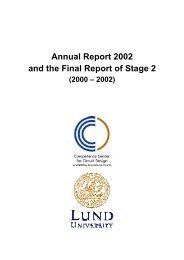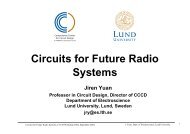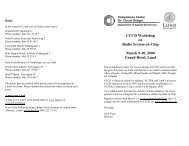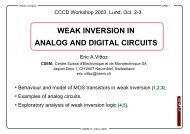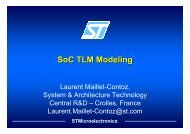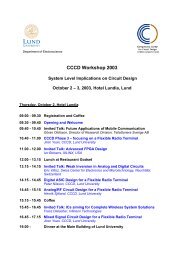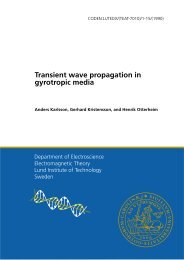Design of Antennas for Handheld DVB-H ... - Lunds tekniska högskola
Design of Antennas for Handheld DVB-H ... - Lunds tekniska högskola
Design of Antennas for Handheld DVB-H ... - Lunds tekniska högskola
Create successful ePaper yourself
Turn your PDF publications into a flip-book with our unique Google optimized e-Paper software.
3 Possible solutions<br />
This chapter describes different existing antenna types that can receive a TV<br />
signal.<br />
3.1 Dipole and Monopole antenna<br />
The dipole is one <strong>of</strong> the most basic antennas. It consists <strong>of</strong> a straight piece <strong>of</strong> wire<br />
that is cut at the centre and fed with a balanced generator. This type <strong>of</strong> antenna is<br />
resonant at the frequency were the conductor length is a half wavelength. This<br />
means that to be resonant at 600 MHz (λ=500mm) it needs a length <strong>of</strong> 250mm<br />
A quarterwave monopole is a ground plane dependent antenna that must be fed<br />
single ended, which makes it an unbalanced antenna. The ground plane is very<br />
important, because the larger the ground plane the more efficient antenna. The<br />
ground plane is half <strong>of</strong> the monopole antenna that has a radiation pattern like the<br />
dipole antenna. It depends on that a quarter wave monopole “mirrors” itself in the<br />
ground plane, much in the same way one sees their own reflection in the water.<br />
According to that is the length <strong>of</strong> a quarter wave monopole antenna half <strong>of</strong> a<br />
dipole antenna, at 600 MHz 125 mm [27].<br />
3.2 Yagi-Uda<br />
The Yagi-Uda antenna is a wideband antenna that is a very good radiator in the<br />
frequency range 3-3000 MHz. This antenna consists <strong>of</strong> a number <strong>of</strong> linear dipole<br />
elements, as shown in figure 3.1. The first dipole element after the reflector is<br />
energized directly by a feed transmission line. The rest <strong>of</strong> the elements act as<br />
parasitic radiators, the currents are induced in these elements by mutual coupling.<br />
The parasitic elements in the direction <strong>of</strong> the beam are smaller in length than the<br />
feed element. Typically the length <strong>of</strong> the feed element is 0.45-0.49λ and the<br />
directors are about 0.4-0.45λ. It is not necessary <strong>for</strong> the directors to be <strong>of</strong> the same<br />
length or to have the same diameter. The separation between the directors are also<br />
not necessary the same <strong>for</strong> uni<strong>for</strong>m design.<br />
The most common feed element <strong>for</strong> Yagi-Uda antenna is a folded dipole. When<br />
this folded dipole is used all elements placed behind it will act as reflectors. The<br />
major role <strong>of</strong> the reflector is played by the one placed next to the energized<br />
element. Very little is gained with a second reflector.<br />
The high gain <strong>of</strong> a Yagi-Uda antenna comes from the directors, the more directors<br />
the higher gain. Practically very little is gained by the addition <strong>of</strong> more than 12<br />
directors, usually 6-12 are used. However, many arrays have been designed and<br />
built with 30 to 40 elements, with a typical gain <strong>of</strong> about 15-17.5 dBi [28].<br />
26



